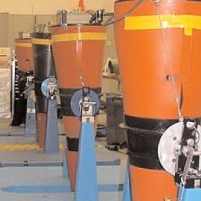Scientists Forget How to Build Nuclear Bomb
Sunday, May 31, 2009
 W76 warheads9Photo: Sandia National Laboratories)
W76 warheads9Photo: Sandia National Laboratories)
After spending billions of dollars to create the nation’s stockpile of nuclear weapons, the government’s top scientific minds apparently forgot one very important task: Write down the instructions for how to make a nuclear weapon explode. Such is the predicament today at the Department of Energy, which oversees the thousands of warheads sitting around and collecting dust since the end of the Cold War almost 20 years ago.
In order to keep the nuclear arsenal primed for war, the government needs to replace aging warheads that first came off the assembly line in the 1970s and 1980s with refurbished models—only they can’t because no one working today at the nation’s weapons laboratories knows how to fashion a key element that makes the warheads blow up. At the center of this huge problem is a particular warhead known as the W76, which makes up more than half of the U.S. arsenal, and is used in the Navy’s Trident missile submarine system.
The National Nuclear Security Administration (NNSA), the wing of the Energy Department in charge of nuclear weapons, has spent $200 million to deliver new W76s to the Navy, and in February, the NNSA claimed to have finally done just that when it announced the delivery of the first retooled warhead. Only that claim wasn’t true, according to the Navy, which said the warhead was still in pieces at the Energy Department’s Pantex plant in Amarillo, Texas.
Turns out the warhead had not been assembled because it was missing a key component known by its code word “fogbank”—an exotic material that’s added to the weapon to make it reach critical mass before exploding. But it seems key people at Lawrence Livermore National Laboratory, which performed much of the earlier work on warheads, are no longer around, and with their departure went the knowledge of how to make fogbank. The newer, post-Cold War crop of scientists has tried to duplicate the efforts of their predecessors, but without success.
“I don’t know how this happened that we forgot how to make fogbank,” Phillip Coyle, a former deputy director at the laboratory and former assistant secretary of Defense, told the Los Angeles Times. “It should not have happened, but it did.”
The Project on Government Oversight (POGO), a watchdog group, tipped off the Los Angeles Times about the problem with refurbishing warheads. According to a former laboratory weapons designer who talked to POGO, the issue stems from the “profiteering agenda” of the contractors running Lawrence Livermore and Los Alamos National Laboratory who have “chased out” the experts who knew how to build the bombs.
-Noel Brinkerhoff
Program to Refurbish Aging Nuclear Warheads Faces Setbacks (by Ralph Vartabedian, Los Angeles Times)
False Choices at the Nuclear Weapons Complex: We Don't Have to Accept Lies and Shoddy Work in Order to Have a Reliable Stockpile (by Ingrid Drake and Peter Stockton, Project on Government Oversight)
Fogbank (by Jeffrey Lewis, Arms Control Wonk)
- Top Stories
- Unusual News
- Where is the Money Going?
- Controversies
- U.S. and the World
- Appointments and Resignations
- Latest News
- Trump to Stop Deportations If…
- Trump Denounces World Series
- What If China Invaded the United States?
- Donald Trump Has a Mental Health Problem and It Has a Name
- Trump Goes on Renaming Frenzy






Comments